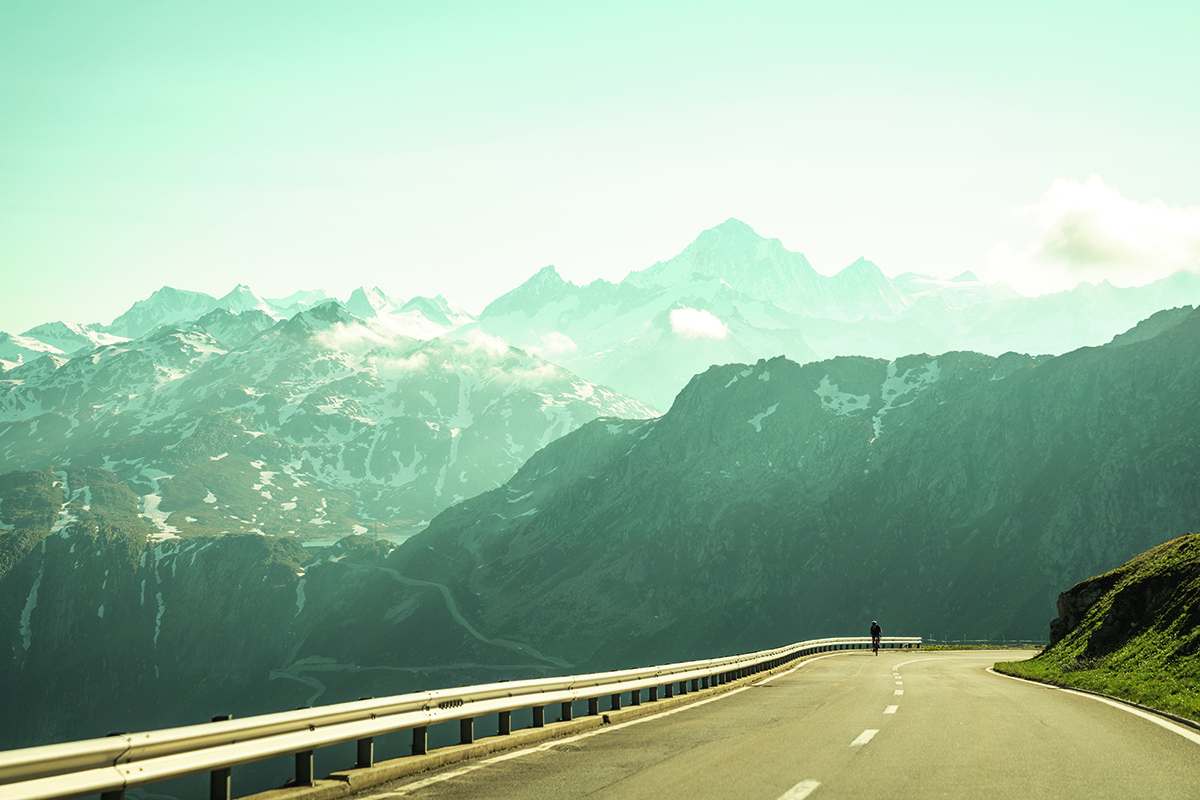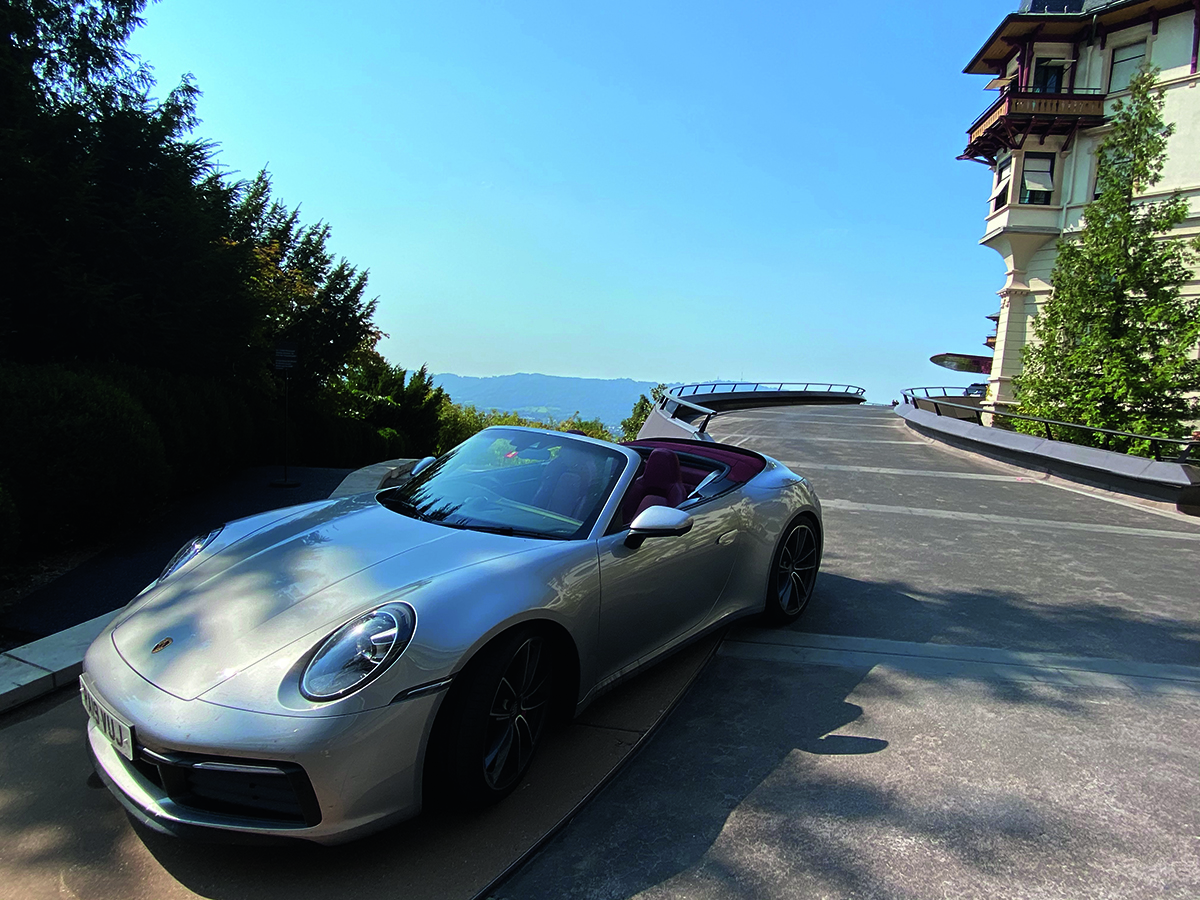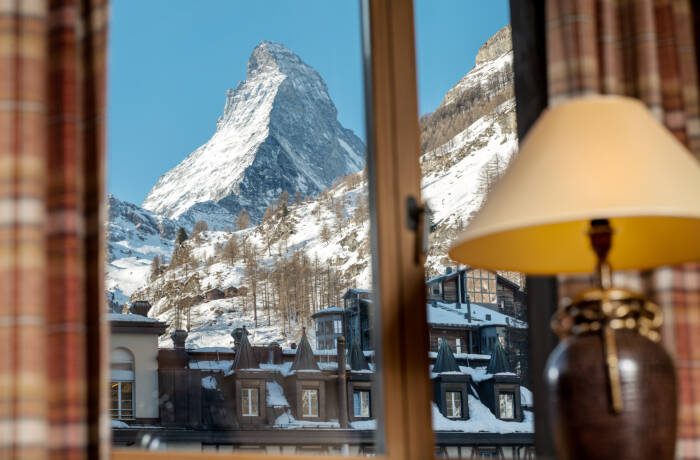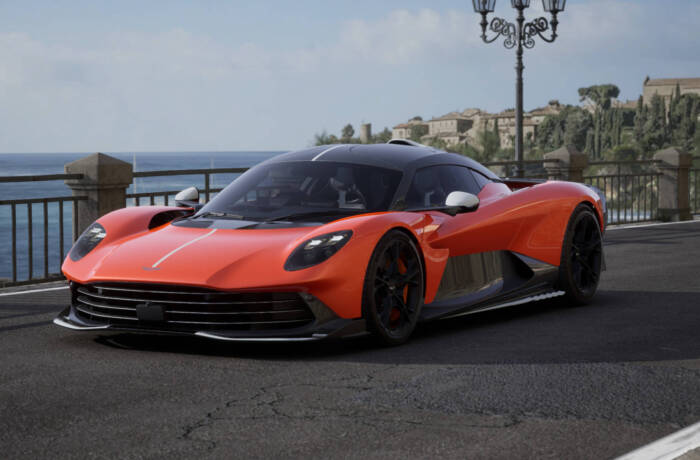
The Porsche 911 Carrera 4S Cabriolet. Courtesy of Switzerland Tourism/André Meier.
In the latest iteration of our Fast & Luxurious car series, LUX’s car reviewer tries out four new versions of well-established models from Porsche, Mercedes-AMG and BMW. First up is the Porsche 911 Carrera 4S Cabriolet
The sequence of events that led to this story is as follows. (1) At an early age, watch the James Bond classic Goldfinger, and be entranced by the sequence where Sean Connery’s Bond drives his Aston Martin DB5 in a chase up the spectacular Furka Pass. (2) Soon after, be driven up and down said pass as a small child, with family, in quite a slow, unremarkable car, whose engine and brakes overheated. Wonder what it would be like to do the same without family, in a proper car, or a proper mission. (3) Many years later. Finish business meeting, sitting outside by the eastern shore of Lake Geneva, on a hot day, clear blue sky, mountains looming all around. Say goodbye to business contact, hit the key button of the car to open roof, sit in car, and look at map (old-fashioned fold-out Michelin map) to plot a route for the rest of the day.
Follow LUX on Instagram: luxthemagazine
My next business meeting was at breakfast the next morning in Andermatt, the swanky new resort development in the middle of the Swiss Alps. The car’s satnav and Google on my phone told me the same way to get there. Around 90 minutes on the motorway looping around the north side of the Alps past Bern, turn right on the motorway to Lucerne, along the east side of Lake Lucerne, and up the valley to Andermatt. Around 3.5 hours all told, a simple route, a scenic one, too, as I remembered, with the Alps constantly keeping you company in a panorama on the right as you traced the semicircle.
However, for every circumference of a semicircle, there is a diameter also. A more direct route. And according to my old fashioned map, the direct looked like an even better bet. Unlike some direct routes in the Alps, it was not only navigable by helicopter or eagle. Instead, I would drive along the very good highway up the Rhône valley, past the towns of Martigny, Sion and Visp, a route that is well known to anyone skiing in the Valais region. It was the last part of the road that was more of an unknown: along the very top of the valley past the source of the Rhône, and then a quick climb up the very same Furka that had appeared in my youthful dreams, and on the other side where Andermatt was literally sitting and waiting for me, with a cold beer in its hand.

La-Tour-de-Peilz, with the Rhône valley in the distance. Image by Darius Sanai
Even accounting for the fact that the mountain-pass road would be slower, it all looked to be a little more than half as long as the Google and satnav route. It was a no-brainer.
What’s more, I could not have chosen a better car in the world to put to bed the memory of the old, slow, overheating family steed. I was sitting in a Porsche 911 Carrera 4S convertible, the latest generation 992 model Porsche 911, with the upgraded engine sported by the S model, a drop top and four-wheel drive. It had been a fantastic companion on my way down from the UK, sitting more happily than a sports car has any right to do on the open road and never feeling fidgety, and then being highly rewarding on the occasional detour on the twisty lanes in central France. And in Geneva, transmission in automatic mode, while taking a conference call over Bluetooth, it had been as docile and hands off as any car could be.
Read more: Sophie Neuendorf on why tokenisation is the art world’s new frontier
The motorway from Vevey to the eastern end of Lake Geneva stands on a viaduct high above the lake, clutching the mountain side to the left. I caught the occasional glimpse of a spectacular sunset on the other side of the lake over the Jura Mountains. The road dropped down at the end of the lake to meet the gaping mouth of the U-shaped Rhône valley – a study in primary school geography. Flanked by steep mountains either side, the motorway swept along the flat valley floor past pastures, small towns and the occasional industrial unit. Fears of rush-hour traffic proved unfounded: the only time the traffic here gets busy is winter when crowds swarm to the Alpine resorts.
Roof down, slightly chilly air pushing down from the glaciers, sun set, the 911 was in its element as I switch the heated seat on and gently cooked the heating up from its lowest setting. It had been a hot day.
I stopped for petrol just after the last town on my route, Brig. All the roads leading to Alpine resorts were behind us, and the route to the Simplon Pass and Milan had also just been passed. The road was now a simple, well-kept main road, no longer a motorway. Curiously, though, there were no signs to Andermatt, Lucerne, or points beyond. How could that be, for what must be a major Alpine pass? The Furka itself was signposted, by a small, rather apologetic sign, as if it was a destination itself. Curious. Still wondering why no destination was signposted along the route, I pressed on.

The sinuous road up to the Furka Pass. Courtesy of Switzerland Tourism/André Meier.
As the Rhône valley rises towards the source of the river that flows through Lake Geneva, Lyon and into the Mediterranean near Marseille, it remains relatively straight but turns into a V-shaped rather than U-shaped valley (geographers will be interested to note). The forests rushing down either side meet in the middle, and the bottom of the valley is nothing more than a fast-rushing big stream.
This meant the road became entertaining as it swept along the valley sides, occasionally entering a couple of bends as it climbed. After a couple of villages, the gradient became steeper. As there was no other traffic at all on the road, this meant the 911 was really in its element.
Read more: Spanish architect Santiago Calatrava on light and space
There are multiple improvements in this new model of Porsche 911. There is its docility in town, which makes it relaxing and effortless to drive at slow speeds – too effortless for some enthusiasts, doubtless. At the opposite end of the driving spectrum is the way it shoots its way into corners. Previous 911s, for engineering and physics reasons related to the fact that the engine is placed behind the back wheels of the car, would happily zoom along the straight part of a country lane, but then require you to brake a bit more than you would in other sports cars before turning into a corner. At that point, you could use the car’s traction and thrust to power your way out. A required technique and highly entertaining, but it also meant you needed to cramp your style a little when entering corners.
Somehow, they have engineered that out of the new model. This car lashes into corners and lashes out of them again, as I discovered as I climbed higher and higher up my road (there was nobody else there, so it was definitely my road). Tear down a straight, brake, turn and be amazed by the sharpness of the steering into the bend, and then tear out, engine howling in the open air behind you. When the car is really going, there is an intimacy of communication, balance and brilliance to it, a complete contrast to its unassuming nature at urban speeds. I found it more accessible, more entertaining and simply more competent than the 991 model that is its predecessor.
Taking a break to admire the view (I had now climbed quite high into the centre of the Alps), I sat in the car, sipping on some caffeinated energy drink. I noted that the interior of the car had also advanced considerably from the previous generation. The design has been simplified while going a couple of notches in quality, feel and sophistication. It feels like a highly grown-up sports car now, and the previous clutter of plasticky switches has disappeared in favour of a well-located touchscreen.

At rest above Lake Zurich. Image by Darius Sanai
Andermatt was now only 30 or so kilometres away as the crow flies (still no signs on the road) so, relishing the idea of my end-of-day beer, I tore on, expecting the road to start winding benignly downwards towards the Andermatt valley. Past a closed hotel that announced its views of the Rhône glacier now sadly so depleted it is no longer visible from the old building. And then suddenly the beautifully surfaced road turned into a narrow strip of tarmac with no barriers. And why is there a wall in front of us?
It was now dark, with no street lights, no cat’s-eyes or anything to light the way apart from the car’s headlamps. I drove gingerly towards the wall, which appeared to be in the middle of the road, only to find myself staring at a hunk of mountainside, with the road doing a 90° turn to the left. Like a cartoon character, I tilted my head backwards up the mountainside, clearly visible in front of me through the open top of the car. The road did not go around this wall; it went up it. And it never seemed to stop.
This was why it wasn’t marked as a through road. This was no longer the time to enjoy the 911’s fabulous steering, precision and cornering joy, as a little too much of that joy would result in the 911 being converted briefly into a flying car before it made a reference to another classic film, The Italian Job, which sees its Lamborghini-driving opening star end up at the bottom of an Alpine precipice, very much not alive.
Around half an hour of inching along in the blackness later, I reached the top of the Furka Pass, at nearly 2,500m as high as a top lift station in a ski resort. Here was the symbolic heart of Europe. Behind me, the rivers flowed south, to the Mediterranean. In front of me, they flowed north, to the North Sea. Peeking out of my side window for the first time, I wondered which remote huts or settlements the pinpricks of light I could see to my right belonged to, before realising that I was looking at stars.
Andermatt now beckoned, a cluster of lights clearly visible in the distance, but unnervingly far beneath me. The way down the other side was similar to the last part of the way up, down a steep wall of a mountainside, doubtless being stared at by some curious ibexes in the darkness. And then the road turned into a far better strip of tarmac at the bottom of the wall, and the car covered the last couple of kilometres in less than a couple of minutes.
There is no better car in which to relive the fantasy drive of your youth. But try and do it during daylight.
LUX rating: 19/20
Find out more: porsche.com
This article was originally published in the Summer 2021 issue.








